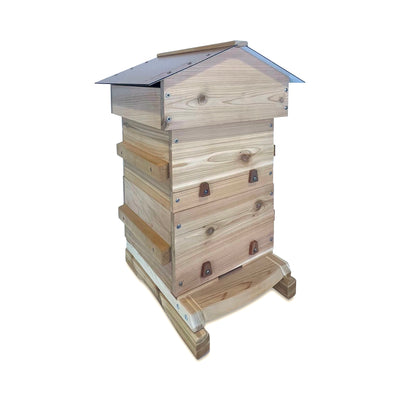Keeping a Mason Bee House
We're fascinated by all pollinators and this week we are focusing on the mighty, mighty mason bee! Read on for what it is, what it does, and how to keep them.

About our Mason Bee House
We designed our mason bee house similarly to our beehives: with the species in mind. The house is constructed of Western Red Cedar and features a shingled roof. The house includes tubes that are the optimal size for nesting. They are made of a breathable cardboard which can be replaced each season. This is much more conducive to bee health than plastic tubes which contain chemicals, cause mold and can cause disease to spread more easily. The clean lines of the house and rich cedar texture make the house a visually pleasing ornament to any garden. Shop it here
What is a mason bee?
Mason bees (and leaf cutter bees) are solitary, tunnel nesting bees. Similarly to honey bees, the female does all of the nesting and foraging to care for the young. Although they are considered solitary because they are not part of a superorganism, mason bees are gregarious! Multiple mason bee "families" will often inhabit the same home without working together.

What does the mason bee lifecycle look like?
Male mason bees emerge from their cells first, only after there have been three consecutive days above 55 degrees. They leave the home to forage for nectar and then return to wait for the females. When the females emerge, mating occurs immediately and the males die. Females then forage for nectar and pollen and bring it back to their tube to groom the pollen off their bodies and into a sticky ball with nectar. She then lays an egg on the food ball, and seals that cavity of the tube off with mud. She does this about 6 times in a tube that is 6 inches long, and a minimum of 5/16" in diameter. After she caps the tube with mud and finishes laying her 6 eggs, she dies.The eggs hatch and larvae eat the food left by mom, and pupate (form cocoons) inside the tube, where they will remain until the next spring when the cycle repeats itself.
How do mason bees find these tubes to nest in?
Mason bees do not have drilling mouth parts to make their own holes, so in the nature, they inhabit holes made by carpenter bees, or woodpeckers. Humans can also make their lives easier by providing an already-made home. Many people simply drill holes in a block as mason bee houses. This is less than ideal because they get re-used and spread disease. The better idea is to use paper tubes, or reeds because they can be replaced by fresh ones. The cocoons can be removed from the tube, cleaned, and stored in the refrigerator for the winter.
Why keep a mason bee house?
Keeping a mason bee house in the garden is ideal for those who aren't ready for the commitment of colony beekeeping. Although keeping mason bees is a low maintenance hobby, there is a huge pollination payoff! Since mason bees are native pollinators, they are experts at pollinating native plants. While honeybees have a 5% efficiency rate when it comes to pollination, mason bees are 95% effective at pollination! They are dynamic at pollinating the immediate area surrounding their nests, which make them perfect for your backyard garden and fruit trees. Lastly, they don't sting and they're cute!
Tips for keeping a mason bee house
- Mason bees only have a 100 yard foraging radius from their nest, so they will need to have staggered bloom flowers within that radius all season.
- House should be sheltered from rain
- House should get direct morning sunlight.
- House should be at least 6 feet off the ground to protect from pests.






Leave a comment